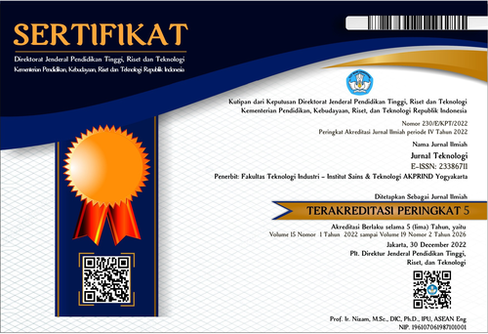Analisis Triple Helix Peran Stakeholder Dalam Meningkatkan Penggunaan Motor Listrik Di Indonesia
DOI:
https://doi.org/10.34151/jurtek.v15i2.3167Keywords:
electric motor, government, industry, triple helix, universityAbstract
In this modern era, the use of electric vehicles is not a new thing. The grand strategy of energy national (GSEN) has fourteen strategic programs to be implemented, one of them is increasing the use of battery- electric vehicles motorized, in order to reduce the imports of fuel oil (BBM) and LPG as well as equitable electrification in Indonesia. This program needs to support by cooperation and role contribution from participants (stakeholders). This study was conducted to determine the role of stakeholders to increasing the use of electric motors in Indonesia using a triple helix methode. The data collection was carried out through interviews and documentation studies. The analyze data was use miles and hubberman. The results showed that based on the triple helix analysis, there were 3 stakeholders involved to increasing the use of electric motors in Indonesia. There were universities, industry and government. The universities have a role in conducting research and development for electric motor products, this can be done through final project research or providing research grants the development electric motors topic. The industry has a role in producing electric motors, for example Gesit Companies which produces electric motors, and also raw materials industry and spare part industry as well as component of electric motors. The government has a role in regulations through policies of equitable electrification motor vehicles in Indonesia. One of them is from the Minister of Transportation Regulation (Permenhub) Number 65 of 2020 concerning the conversion of fuel motorcycles into battery-electric motorcycles.
Downloads
References
Adi, I. P., Kumara, I. S., & Agung, I. (2021). Status Perkembangan Sepeda Listrik Dan Motor Listrik Di Indonesia. Jurnal SPEKTRUM, Vol. 8, No. 4, 8-19.
Asti, M., Supriyadi, I., & Yusgiantoro, P. (2020). Analisis Penggunaan Sepeda Motor Listrik Bagi Transportasi Online Terhadap Ketahanan Energi (Studi Pada Gojek). Jurnal Ketahanan Energi, Vol. 6, No. 1, 19-38.
Dahiri, R. (2021). Tantangan dalam Pengembangan Kendaraan Bermotor Listrik Berbasis Baterai (Battery Electric Vehicle). Buletin APBN, Vol. 6, Ed. 6, 12-15.
Etzkowitz, H. (2008). The Triple Helix (University–Industry–Government Innovation in Action). New York: Routledge.
Ghosal, A. (2019, Agustus 5). India unveils ambitious plan to have only electric cars by 2030. Retrieved from India Business Time: https://www.ibtimes.co.in/
Kemenhub RI. (2021). Kendaraan Listrik Masa Depan Transportasi Indonesia. Retrieved from Dephub.go.id: https://dephub.go.id/post/read/kendaraan-listrik-masa-depan-transportasi-indonesia
Mazda, C. N., Makhtum, M., & Putra A, I. N. (2019). Pengendalian Kualitas Industri Kreatif Budaya Di Era Industri 4.0 Sebagai Pendukung Ekonomi Pertahanan Negara (Studi Kasus: CV Kayu Manis Yogyakarta). Seminar Nasional IENACO (pp. 105-112). Surakarta: UMS.
Mazda, C. N., Putra A, I. N., & Dadang A R, D. (2020). Strategi Pengembangan Industri PT INKA Terhadap Kesiapan Distribusi Logistik Kewilayahann Dalam Mendukung Sistem Pertahanan Negara. Jurnal Industri Pertahanan, Vol. 2, No. 1, 65-80.
Merina, B., & Mazda, C. N. (2022). Implementasi Teori Kepemimpinan Dalam Pemilihan Pamong Kalurahan Wedomartani, Ngemplak, Sleman, Yogyakarta. Jurnal Enersia Publika, Vol. 6, No. 1, 30-41.
Moleong, J. L. (2002). Metodologi Penelitian Kualitatif. Bandung: Remaja Karya.
Mukhlis, A., & Judianto, O. (2017). Kajian Teknologi Pada Sepeda Motor Bertenaga Listrik. Jurnal Inosains Vol. 12 No. 2, 36-41.
Pribadi, A. (2022). Pemerintah Kenalkan GSEN pada Presidensi G20 Indonesia. Retrieved from Direktorat Jenderal Energi Baru, Terbarukan dan Konservasi Energi (EBTKE): https://ebtke.esdm.go.id/post/2022/02/07/3073/pemerintah.kenalkan.gsen.pada.presidensi.g20.indonesia?lang=en
Rizaty, M. A. (2022). Motor Listrik di Indonesia Diproyeksi Mencapai 13 Juta Pada 2030. Retrieved from Data Indonesia.id: https://dataindonesia.id/sektor-riil/detail/motor-listrik-di-indonesia-diproyeksi-mencapai-13-juta-pada-2030
Subekti, R. A., Sudibyo, H., Susanti, V., Saputra, R. M., & Hartanto, A. (2014). Peluang dan Tantangan Pengembangan Mobil Listrik Nasional. Jakarta: LIPI Press.
Umah, A. (2021). Jokowi Bakal Rilis Perpres Grand Strategi Energi Nasional. Retrieved from CNBC Indonesia: https://www.cnbcindonesia.com/news/20210624115820-4-255593/jokowi-bakal-rilis-perpres-grand-strategi-energi-nasional
Wirabrata, A. (2019). Percepatan Program Kendaraan Bermotor Listrik di Indonesia. Info Singkat- Bidang Ekonomi dan Kebijakan Publik, Vol. 11, No. 14, pp. 19-24.). triplr
Downloads
Published
How to Cite
Issue
Section
License
Copyright (c) 2022 Chadziqatun Najilatil Mazda, Dwi Agustina Kurniawati, Ira Setyaningsih

This work is licensed under a Creative Commons Attribution 4.0 International License.
Jurnal Teknologi provides immediate open access to its content in order of making research freely available to the public to support a global exchange of knowledge. All articles published in this journal are free for everyone to read and download, under licence CC BY SA.
Benefits of open access for the author, include:
- Free access for all users worldwide.
- Authors retain copyright to their work.
- Increased visibility and readership.
- No spatial constraints.




















